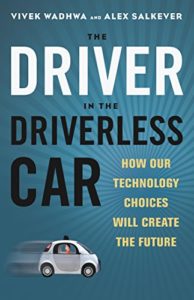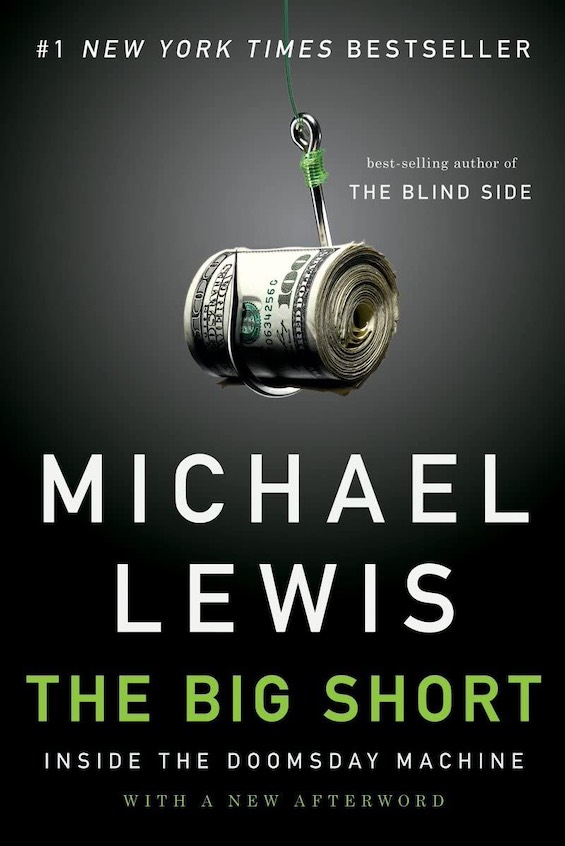
Not long ago, I was very pessimistic about the future. . . Today, I talk about this being the greatest period in history, when we will solve the grand challenges of humanity and enter an era of enlightenment and exploration such as we saw in my favorite TV series, Star Trek.” Thus begins The Driver in the Driverless Car: How Our Technology Choices Will Create the Future, by Vivek Wadwa and Alex Salkever.
An authoritative look at technology’s potential
In this fascinating and authoritative look at the potential of technology, both positive and negative, Wadhwa demonstrates intimate knowledge of the latest developments in such diverse fields as biomedicine, robotics, education, the Internet of Things, and prosthetics. Unlike the unreservedly optimistic scenarios presented by Ray Kurzweil and Peter Diamandis, Wadhwa paints an almost symmetrical portrait of technology’s future, extolling its promise but vividly describing its potential to harm us. I previously reviewed Abundance: The Future Is Better Than You Think by Diamandis.
Ray Kurzweil famously speaks about the exponential rate at which technology advances. Wadhwa bases his argument on the same formula but reaches different conclusions. “You will see that there is no black and white,” he writes; “the same technologies that can be used for good can be used for evil in a continuum limited only by the choices we make jointly.”
It’s a cliché to remark on the speed of technological change, but the reality is nonetheless staggering. As Wadhwa notes, “the amount of information buzzing over the Internet is doubling roughly every 1.25 years. . . We are now creating more information content in a single day that we created in decades or even centuries in the pre-digital era.” He adds, “the iPhone 11 or 12 will have greater computing power than our brains do.”
The Driver in the Driverless Car: How Our Technology Choices Will Create the Future by Vivek Wadwa and Alex Salkever ★★★★★
Three questions to ask about any new technology
The Driver in the Driverless Car is organized around three broad questions, which Wadhwa poses in connection with each of the technologies he discusses: “1. Does the technology have the potential to benefit everyone equally? 2. What are the risks and the rewards? 3. Does the technology more strongly promote autonomy or dependence?” He is merciless in responding to these questions. Only two of the many technologies treated in this book emerge with unreservedly positive reviews: driverless cars and trucks, and solar power.
Everything else comes up short, from the biomedical miracles emerging from laboratories on a daily basis to the Internet of Things. In a great many cases, the new technologies render us susceptible to identity theft or worse. For example, Wadhwa fears the loss of privacy that will come from having all our appliances connected to the Internet and to each other: “I am not looking forward to having my bathroom scale tell my refrigerator not to order any more cheesecake.”
A sometimes fantastic vision of the future
Disputing Wadhwa’s sometimes fantastic vision of technology’s future may be a fool’s errand. However, it’s difficult not to remain skeptical about some of his predictions. For example, he envisions 200-mile-per-hour driverless cars guided by a web of sensors on the roadways. Despite the miniscule cost of individual sensors, it’s hard to see where the money might come from to implement such a system. Can you imagine how much it might cost to embed sensors along a 200-mile stretch of highway, much less the full 381 miles from San Francisco to Los Angeles?
Similarly, the author envisions a sea change in our transportation system within the foreseeable future, with driverless electric cars available on command everywhere, private vehicles and stop lights eliminated, and parking lots a thing of the past. Perhaps, eventually, all this might come to pass. But is it realistic to expect that politicians will resist the screaming complaints from auto manufacturers, oil companies, service station and parking lot owners, and individual citizens by the millions?
Wadhwa emphasizes throughout The Driver in the Driverless Car that only grassroots citizen pressure can force politicians to enact the legislation necessary to permit the widespread use of some of these technologies. For instance, FDA approval may be necessary for the acceptance of many of the biomedical innovations Wadhwa describes. And state governments everywhere will be required to allow driverless vehicles to travel on their roads, a prospect that does not seem imminent. The future Wadhwa envisions may eventually come to pass. But we would be naive to expect no bumps, twists, and turns along the way.
About the authors
Vivek Wadwa has an extraordinary resumé. An Indian-born American futurist, he lives in Silicon Valley and researches technology developments there. Wadhwa holds distinguished positions at Carnegie Mellon and Duke and is a globally syndicated columnist for the Washington Post. In 2012, Foreign Policy magazine named him one of the world’s Top 100 Global Thinkers. Wadhwa calls his co-author, Alex Salkever, V.P of Marketing Communications at Mozilla, his “writing guru.” The two also co-authored The Immigrant Exodus: Why America Is Losing the Global Race to Capture Entrepreneurial Talent, which the Economist named a Book of the Year in 2012.
For related reading
This is one of the books I’ve included in my posts, Gaining a global perspective on the world around us, 5 best books about Silicon Valley, and 10 best books about innovation.
It’s also one of 20 good nonfiction books about the future.
You might also enjoy Science explained in 10 excellent popular books.
If you enjoy reading nonfiction in general, you might also enjoy:
- Great biographies I’ve reviewed: my 10 favorites
- My 10 favorite books about business history
- 20 top nonfiction books about history
And you can always find my most popular reviews, and the most recent ones, on the Home Page.



























